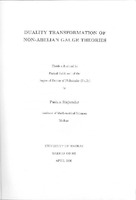- DSpace Home
- →
- IMSc Theses/ Dissertations
- →
- IMSc Theses/ Dissertations
- →
- View Item
JavaScript is disabled for your browser. Some features of this site may not work without it.
| dc.contributor.author | Majumdar, Pushan | |
| dc.date.accessioned | 2009-08-25T11:35:29Z | |
| dc.date.available | 2009-08-25T11:35:29Z | |
| dc.date.issued | 2009-08-25T11:35:29Z | |
| dc.date.submitted | 2000 | |
| dc.identifier.uri | https://dspace.imsc.res.in/xmlui/handle/123456789/90 | |
| dc.description.abstract | Duality transformation typically maps the strongly coupled region of one theory to the weakly coupled one of another, making it possible for one to investigate the strongly coupled region of a theory by a perturbative expansion of the dual theory. Duality transformation of an abelian gauge theory, gives the dual potential, one which couples minimally to magnetic matter and exposes the monopole degrees of freedom. This thesis develops techniques for performing duality transformation of 2+1 and 3+1 dimensional Yang-Mills theories. An analogy that exists between gravity and gauge theory is reviewed. It plays an important role for SU(2) gauge theory in three dimensions. The duality transformation for 2+1 dimensional (continuum) Yang-Mills theory in close analogy to the case of compact U(1) lattice gauge theory is considered. The Yang-Mills theory is interpreted as a theory of 3-manifolds as in gravity but without diffeomorphism invariance. Dual gluons and their interactions are identified, using this relation. The monopoles are located at singular points of the new coordinate system which is constructed using Ricci Tensor; They have the expected interactions with the dual gluons. It is expected that these interactions lead to a mass for the dual gluons and result in confinement as in U(1) case. The fourth chapter deals with the problem of gauge field copies. It is shown that for every given magnetic field, there corresponds a vector potential and there exists one gauge field copy which is unique up to boundary conditions. The fifth chapter discusses the solution of the non-Abelian Gauss law and Non-Abelian analogs of the Hodge decomposition. The duality transformation of four dimensional Yang-Mills theory is discussed in the sixth chapter. Then fixing the axial gauge, the duality transformation of Yang-Mills theory in three or four dimensions is carried out. | en_US |
| dc.subject | Duality Transformation | en_US |
| dc.subject | Yang-Mills Theory | en_US |
| dc.subject | Gauge Theory | en_US |
| dc.title | Duality transformation of non-abelian gauge theories | en_US |
| dc.type.degree | Ph.D | en_US |
| dc.type.institution | University of Madras | en_US |
| dc.description.advisor | Sharatchandra, H. S. | |
| dc.description.pages | x; 80p. | en_US |
| dc.type.mainsub | Physics | en_US |
Files in this item
This item appears in the following Collection(s)
-
IMSc Theses/ Dissertations
IMSc Theses/ Dissertations
